China’s Position on the China-US Economic and Trade Consultations

The State Council Information Office of
The People’s Republic of China
(June 2019)
Contents
Preface
I. Economic and trade friction provoked by the US damages the interests of both countries and of the wider world
II. The US has backtracked on its commitments in the China-US economic and trade consultations
III. China is committed to credible consultations based on equality and mutual benefit
Conclusion
Preface
The China-US commercial relationship serves as both the ballast and the propeller of the overall bilateral relationship. At stake are the fundamental interests of the two peoples, and the prosperity and stability of the world. Since the establishment of diplomatic relations between China and the US, bilateral trade and economic relations have come a long way, with expanding fields of cooperation at higher levels. A mutually beneficial and win-win relationship with strong complementarity and interlinked interests has been forged, benefiting not only the two countries but also the entire world.
Given the differences in stage of development and economic system, it is inevitable that the two countries will experience differences and friction in their commercial cooperation. The history of China-US trade and economic relations has seen twists and turns and difficult situations. By adopting a rational and cooperative attitude, the two countries have managed to resolve previous conflicts, bridge differences, and render the bilateral commercial relationship more mature through dialogue and consultation.
Since it took office in 2017, the new US administration has threatened additional tariffs and other measures and provoked frequent economic and trade friction with its major trading partners. In response to the economic and trade friction unilaterally initiated by the US since March 2018, China has had to take forceful measures to defend the interests of the nation and its people. At the same time, committed to resolving disputes through dialogue and consultation, China has engaged in multiple rounds of economic and trade consultations with the US in an effort to stabilize the bilateral commercial relationship. China’s position has been consistent and clear – that cooperation serves the interests of the two countries, that conflict can only hurt both, and that cooperation is the only correct choice for both sides. Concerning their differences and frictions on the economic and trade front, China is willing to work together with the US to find solutions, and to reach a mutually beneficial and win-win agreement. However, cooperation has to be based on principles. There are bottom lines in consultations. China will not compromise on major issues of principle. China does not want a trade war, but it is not afraid of one and it will fight one if necessary. China’s position on this has never changed.
To provide a comprehensive picture of the China-US economic and trade consultations, and present China’s policy position on these consultations, the Chinese government hereby issues this White Paper.
I. Economic and trade friction provoked by the US damages the interests of both countries and of the wider world
Trumpeting “America First”, the current US administration has adopted a series of unilateral and protectionist measures, regularly wielded tariffs as a “big stick” and coerced other countries into accepting its demands. The US has initiated frequent investigations under the long-unused Sections 201 and 232 against its main trading partners, causing disruption to the global economic and trade landscape. Specifically targeting China, in August 2017 it launched a unilateral investigation under Section 301. Turning a blind eye to China’s unremitting efforts and remarkable progress in protecting intellectual property and improving the business environment for foreign investors, the US issued a myriad of slanted and negative observations, and imposed additional tariffs and investment restrictions on China, provoking economic and trade friction between the two countries.
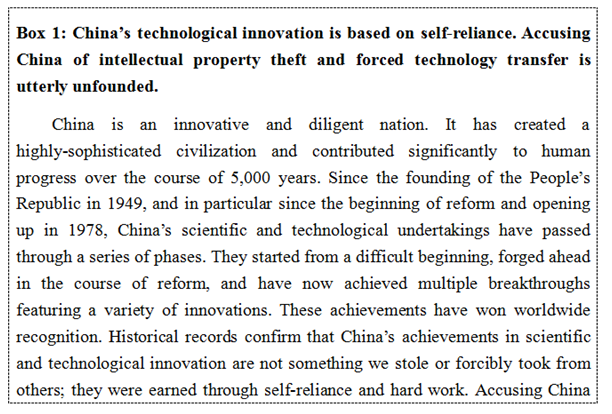
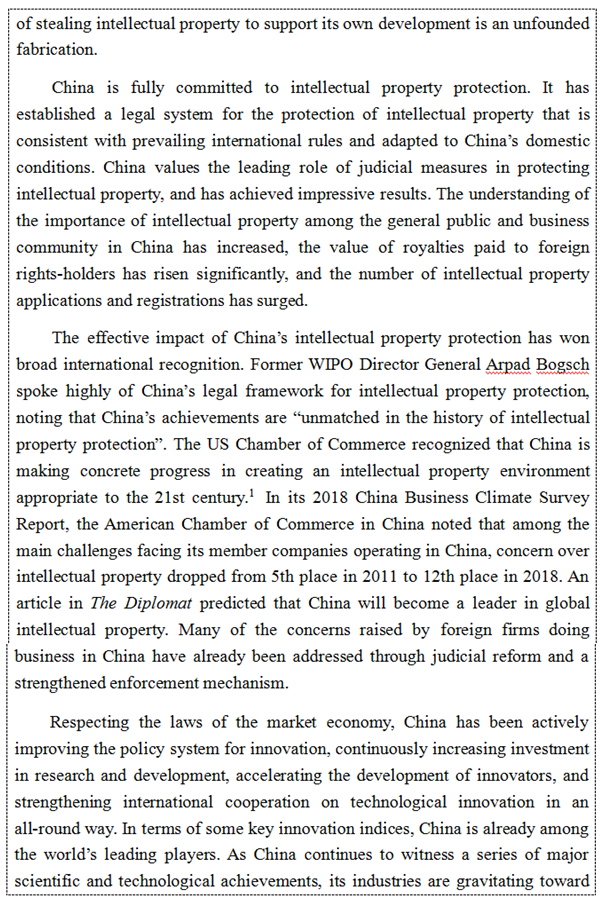
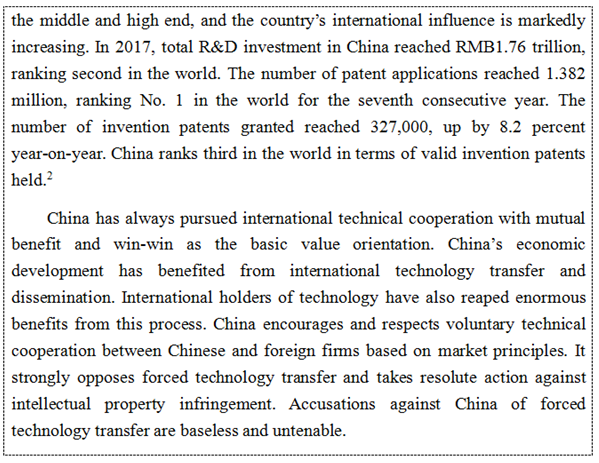
Turning a blind eye to the nature of the economic structure and the stage of development in China and the US, as well as the reality of the international industrial division of labor, the US insists that China’s “unfair” and “non-reciprocal” trade policies have created a trade deficit in bilateral commercial exchanges that constitutes “being taken advantage of”, leading to unilateral imposition of additional tariffs on China. In fact, in today’s globalized world, the Chinese and American economies are highly integrated and together constitute an entire industrial chain. The two economies are bound in a union that is mutually beneficial and win-win in nature. Equating a trade deficit to being taken advantage of is an error. The restrictive measures the US has imposed on China are not good for China or the US, and still worse for the rest of the world.


(I) The tariff measures the US imposed harm others and are of no benefit to itself
The US administration has imposed additional tariffs on Chinese goods exported to the US, impeding two-way trade and investment cooperation and undermining market confidence and economic stability in the two countries and globally. The US tariff measures lead to a decrease in the volume of China’s export to the US, which fell by 9.7 percent year-on-year in the first four months of 20194,dropping for five months in a row. In addition, as China has to impose tariffs as a countermeasure to US tariff hikes, US exports to China have dropped for eight months in a row5.The uncertainty brought by US-China economic and trade friction made companies in both countries more hesitant about investing. China’s investment in the US continues to fall and the growth rate of US investment in China has also slowed down. According to Chinese statistics, direct investment by Chinese companies in the US was US$5.79 billion in 2018, down by 10 percent year-on-year6.In 2018, paid-in US investment in China was US$2.69 billion7,up by only 1.5 percent year-on-year compared with an increase of 11 percent in 2017. With the outlook for China-US trade friction unclear, the WTO has lowered its forecast for global trade growth in 2019 from 3.7 percent to 2.6 percent8.
(II) The trade war has not “made America great again”
The tariff measures have not boosted American economic growth. Instead, they have done serious harm to the US economy.
First, the tariff measures have significantly increased production costs for US companies. The Chinese and US manufacturing sectors are highly dependent on each other. Many American manufacturers depend on China’s raw materials and intermediary goods. As it is hard for them to find good alternative suppliers in the short term, they will have to bear the costs of the tariff hikes.
Second, the tariff measures lead to domestic price hikes in the US. The import of value-for-money consumer goods from China is a key factor behind the long-term low inflation in the US. After the additional tariffs were imposed, the final selling price of Chinese products increased, leaving American consumers effectively bearing some tariff costs. According to research by the US National Retail Federation, the 25 percent additional tariffs on furniture alone will cost the US consumer an additional US$4.6 billion per year9.
Third, the tariff measures have an impact on US economic growth and people’s livelihood. A joint report by the US Chamber of Commerce and the Rhodium Group in March 2019 showed that, under the impact of China-US economic and trade friction, US GDP in 2019 and the next four years could decrease by US$64-91 billion per year, about 0.3-0.5 percent of total US GDP. If the US imposes 25 percent tariffs on all Chinese goods exported to the US, US GDP will decrease by US$1 trillion in the next ten years cumulatively10. According to a research report in February 2019 by Trade Partnership, an American think-tank, if the US imposes 25 percent additional tariffs on all imported Chinese goods, US GDP will decrease by 1.01 percent, with 2.16 million job losses and an additional annual burden of US$2,294 on a family of four11.
Fourth, the tariff measures lead to barriers to US exports to China. The 2019 State Export Report, published by the US-China Business Council on May 1, 2019, stated that in the ten years from 2009 to 2018, US exports to China supported over 1.1 million jobs. The Chinese market continues its importance to US economic growth. Forty-eight states of the US have increased their goods exports to China during the last decade – 44 of them by double digits – while in 2018, when economic and trade friction worsened, only 16 states increased their goods exports to China. Thirty-four states exported fewer goods to China, with 24 of them seeing a double-digit decrease. The Midwestern agricultural states were hit particularly hard. Under tariff measures, exports of American agricultural produce to China decreased by 33.1 percent year-on-year, including a 50 percent drop in soybeans. US businesses are worried that they might lose the Chinese market, which they have been cultivating for nearly 40 years.
MOST POPULAR
- 1 Things to know about China Intl Consumer Products Expo 2024
- 2 China tops FDI confidence index of emerging markets
- 3 China specifies steps to improve payment services in tourist attractions
- 4 Low-altitude economy set to take off
- 5 China's immigration service platform receives over 10m calls from home, abroad
Editors' Picks
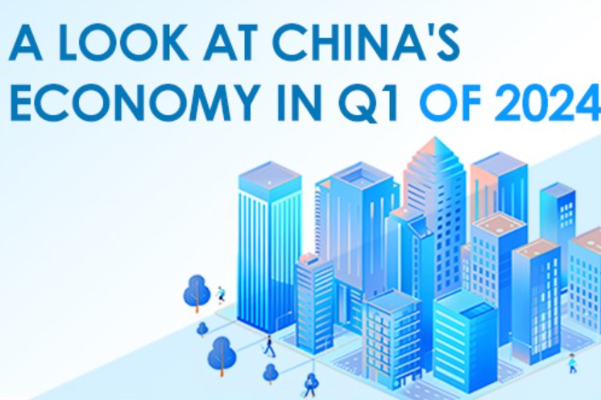 Infographic:
A look at China's economy in Q1 of 2024
Infographic:
A look at China's economy in Q1 of 2024
 Infographic:
China to remove foreign ownership restrictions in value-added telecom services in pilot areas
Infographic:
China to remove foreign ownership restrictions in value-added telecom services in pilot areas
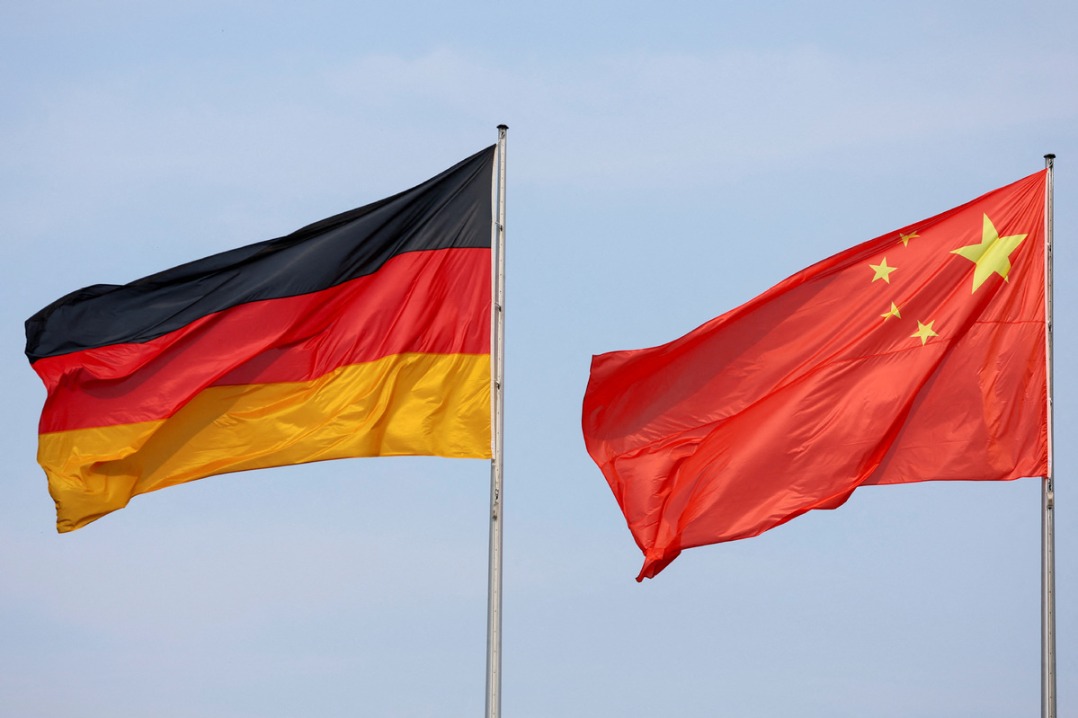 Infographic:
2023 Sino-German investment and trade in numbers
Infographic:
2023 Sino-German investment and trade in numbers
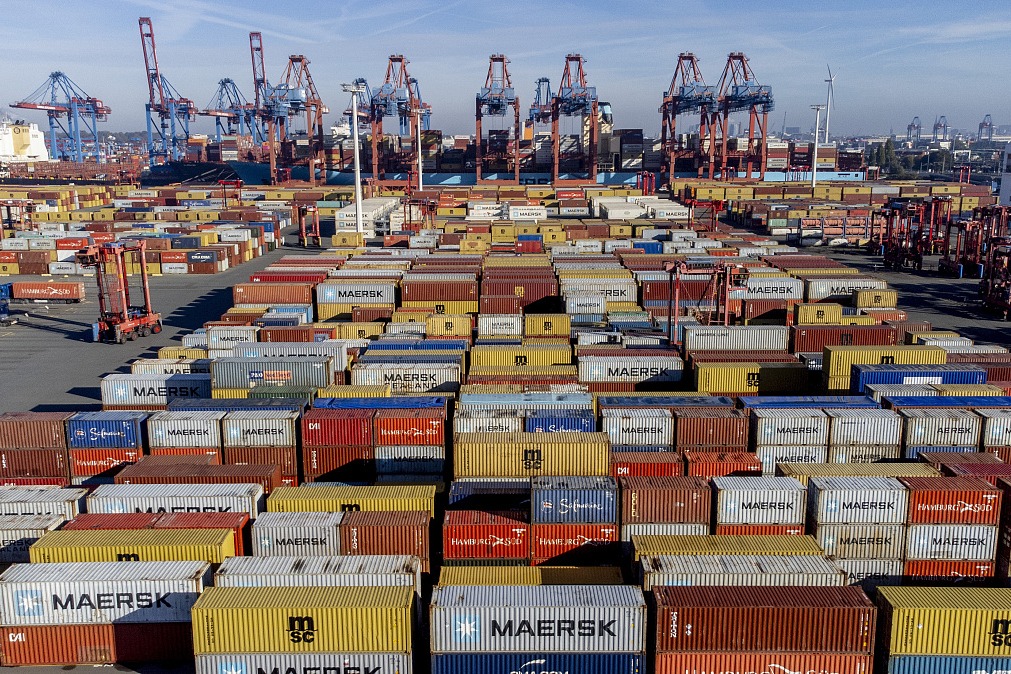 Infographic:
China-Germany relations in graphic
Infographic:
China-Germany relations in graphic



